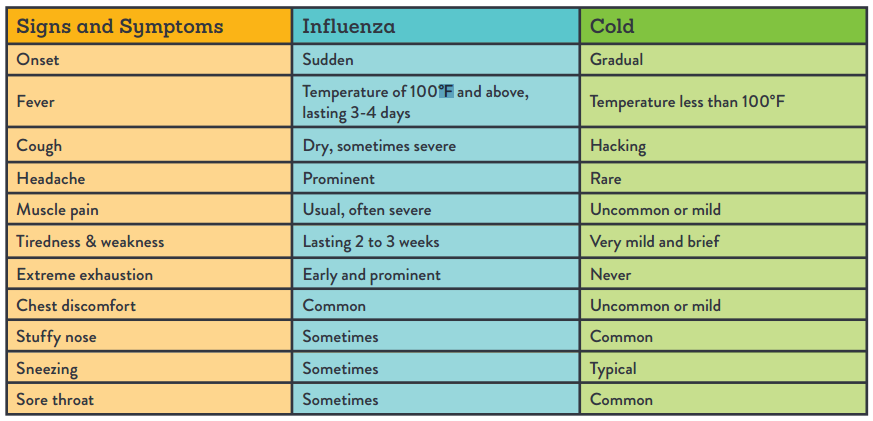
Cold versus flu: 5 ways to spot the difference
Knowing what you have will change your course of action
Cough. Sneeze. Shiver. Hack.
There are dozens, possibly hundreds of words to describe the physical symptoms we experience when we get sick.
Is it a wheezing dry cough, or phlegm-filled sneeze? Did you start feeling feverish quickly, or over a few days? While not always pleasing to talk about, these pesky details can be important signs in spotting the difference between a common cold and seasonal flu. And catching the symptoms early can help you take the right course of action to recover quickly. If you think you might have influenza please call and talk to one of our nurses right away.
Get advice from a nurse
With HealthPartners CareLine (612-339-3663 or 800-551-0859) and Park Nicollet’s nurse line, you can talk directly with a nurse 24/7, 365 days a year completely free of charge. They can help you decide if it’s time to see a doctor, as well as provide helpful home remedy advice.
Influenza is serious. Last year an estimated 80,000 Americans died and over 700,000 were hospitalized from influenza. Please schedule your flu shot now to reduce the chance you will get influenza this year.
If you do get sick, here are five ways to spot the differences between cold and flu.
-
Flu onset symptoms hit fast
Influenza (the common “flu”) will often surprise you with how fast it hits, and how serious it can become. Classically, the flu starts with a sudden onset of fever, chills, muscles aches, headache and tiredness. Usually there are other symptoms like runny nose and cough as well. You feel lousy and you feel lousy fast.
A cold, on the other hand, comes on gradually and will last longer. Cold germs are contagious for the first three days. While your cough and congestion may last 3 weeks, other cold symptoms that last more than one week (fever, chest pain, shortness of breath, sinus pain) may signal a bacterial or sinus infection. Colds rarely come with a significant fever, while the flu promises a few days above 100°F. A flu fever will likely come on fast, especially in kids. Keep an eye on the little ones and the elderly, as they will be more susceptible to complications. Keep drinking liquids and get lots of rest.
If you experience any of these symptoms for more than a week, book an appointment with your doctor to get an accurate diagnosis.
-
Dry cough screams flu, cough with phlegm spells cold
The flu will cause a dry cough that does not produce mucus. A cough that is caused by a cold often produces phlegm or mucus.
-
Sore throat, sneezing, stuffy nose accompanies cold
If you have these symptoms, you most likely have a cold. While sneezing or a stuffy nose could accompany the flu, they are less common than during a cold.
-
The flu comes with muscle aches
Aches and pains are very common with the flu but rare with a cold. If you’re running a fever and experiencing general achiness, it’s almost certainly the flu.
-
Flu and extreme fatigue
If you’re dragging, or feeling extreme fatigue, it’s likely from the flu. Sometimes you’ll continue feeling run down for a few days even after other flu symptoms stop. Remember, there’s nothing wrong with a little extra rest.
On the other hand, a cold will rarely stop you from performing your day-to-day tasks.
We’ve all had colds and know that you can get mild fever or achiness and cough with it. But if you feel like you’ve been hit by a truck, this is more likely flu. Here’s a chart that recaps flu vs cold symptoms:

Bonus: home remedies for flu
If you are sick with flu-like illness, it’s best to stay home for 24 hours after your fever has come down. Here are some steps you can take from home to feel better:
- Get plenty of rest.
- Drink lots of fluids (focus on water).
- The best advice for treating the flu is to avoid it in the first place, so go get a flu shot.
- Take acetaminophen/Tylenol or ibuprofen/Advil to lower your temperature. Warning: Do not give aspirin (acetylsalicylic acid) to children or teenagers who have the flu, as it comes with a small risk of causing the potentially fatal Reye Syndrome.
There are also antiviral medicines available (Tamiflu and Relenza) that treat the flu, which require a prescription and treatment plan. You can get a prescription in-person, or online (see below). These fight the flu by keeping viruses from reproducing in the body. They work best when started within 48 hours after symptoms start.
We can offer the following options for getting healthy again:
Visit urgent care
When it can’t wait, drop in to one of our convenient urgent care locations for treatment without an appointment. And because the flu doesn’t keep office hours, urgent care is open evenings and weekends. Find locations and hours, and view current wait times for HealthPartners and Park Nicollet urgent care in the Twin Cities.
Our HealthStation serves the St. Cloud area and offers weekday and weekend walk-in care with no appointment needed. Find us inside the Coborn’s Superstore in Sauk Rapids.
Live in western Wisconsin? We have you covered, too. For first-come, first-served treatment, you can visit our Westfields Hospital HealthStation walk-in clinic – found just inside the Walmart on Richmond Way, in New Richmond.
Get online treatment with virtuwell
With virtuwell, our 24/7 online clinic, you can get treated for the common cold and the flu in about 30 minutes. We diagnose and treat over 60 common conditions like bronchitis and sinus infections through virtuwell for everyone 2 years of age and older. Each online visit costs $49 or less, depending on your insurance. Visit virtuwell.com to find out more.
About Michael Stiffman, MD
Dr. Michael Stiffman is a family medicine doctor who works at HealthPartners clinics in Inver Grove Heights and St. Paul. He is the medical consultant for Dakota County Public Health Department. Dr. Stiffman received his medical degree from University of Missouri-Columbia School of Medicine and has been practicing medicine for more than 20 years. He is passionate about helping patients live a healthy lifestyle while facing health conditions at every phase of life. He enjoys attending local opera, jazz and other cultural performances with his accomplished wife.



